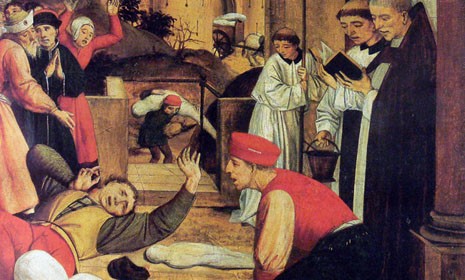Why would scientists re-create the black plague?
In a mash-up of Jurassic Park and CSI: London, scientists crack the genetic code of the deadly bubonic plague that ravaged 14th century Europe

A team of German, Canadian, and U.S. scientists have reconstructed the genetic sequence of one of history's worst plagues. The Black Death swept through Europe between 1347 and 1351, killing 30 million to 50 million people — up to half of Europe's population at the time. The plague "was literally like the four horseman of the apocalypse that rained on Europe," says Johannes Krause of Germany's University of Tubingen, lead author of the study published in Nature. "People literally thought it was the end of the world." Why try to bring it back to life? Here's what you should know:
How did scientists re-create the bacterium's DNA?
Study co-author Kirsten Bos, of Canada's McMaster University, extracted dried blood from the teeth of four 14th-century plague victims exhumed from a London graveyard located under today's Royal Mint. The 660-year-old plague DNA was in bad shape, fractured and mixed with human DNA and other bacteria. But using new techniques and modern disease strains to attract the ancient plague DNA, researchers were able to separate, clean, and sequence the black plague. This "technical tour de force" will be used as a model to re-create the pathogens that caused other ancient epidemics.
The Week
Escape your echo chamber. Get the facts behind the news, plus analysis from multiple perspectives.

Sign up for The Week's Free Newsletters
From our morning news briefing to a weekly Good News Newsletter, get the best of The Week delivered directly to your inbox.
From our morning news briefing to a weekly Good News Newsletter, get the best of The Week delivered directly to your inbox.
Why would you ever resurrect such a deadly bug?
Partly to settle a scientific debate between those who argued that modern strains of the plague bacterium, Yersinia pestis, descended from the original variant that caused the Black Death, and those who said a different bug caused the medieval plagues. This study proves the former group right: The 14th century version of Y. pestis is nearly identical to the less-virulent strains that exist today. "It's the grandmother of all plagues that's around today," says Krause. Studying the original will likely help scientists understand modern-day infectious disease.
Could this spark another Black Death?
No. Even if a resurrected version of this deadly bug escaped the ultra-secure lab, we'd be okay. Today's world is a very different than medieval Europe, and leaps in public health and better living conditions would blunt the disease's spread. And antibiotics would surely snuff it out.
A free daily email with the biggest news stories of the day – and the best features from TheWeek.com
Sources: AP, BBC News, Bloomberg, New York Times, Reuters, TIME
-
 How climate change is affecting Christmas
How climate change is affecting ChristmasThe Explainer There may be a slim chance of future white Christmases
-
 The MAGA civil war takes center stage at the Turning Point USA conference
The MAGA civil war takes center stage at the Turning Point USA conferenceIN THE SPOTLIGHT ‘Americafest 2025’ was a who’s who of right-wing heavyweights eager to settle scores and lay claim to the future of MAGA
-
 The 8 best drama movies of 2025
The 8 best drama movies of 2025the week recommends Nuclear war, dictatorship and the summer of 2020 highlight the most important and memorable films of 2025